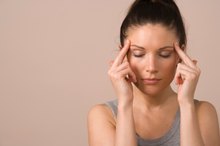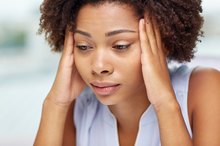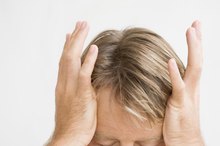Pain in the Base of the Head During Exercise
Exercise can cause pain in the base of the head, which may also be accompanied by nausea and other migraine-like symptoms and pain in other areas of the head. Knowing what type of exercise relates to which headache and the headaches' other symptoms helps you identify what might be causing your pain. See your doctor for changes in severity or patterns of exercise-triggered headaches, or if you become drowsy, numb, feverish or develop a stiff neck.
If you are experiencing serious medical symptoms, seek emergency treatment immediately.
Exertional Headache
Exertional headaches and effort-induced headaches are sometimes lumped in together, but exertional headaches are slightly different. Exercising that involves pushing, pulling and lifting can cause exertional headaches. Sneezing and coughing may, too. Because of the correlation between lifting and exertional headaches, they are sometimes called weightlifting headaches. Pain typically occurs in the occipital area of the neck. The occipital ridge is the bone along the back of the neck and head down to the base of the skull.
- Exertional headaches and effort-induced headaches are sometimes lumped in together, but exertional headaches are slightly different.
- Because of the correlation between lifting and exertional headaches, they are sometimes called weightlifting headaches.
Effort-induced Headache
Left-Sided Headache After Workouts
Learn More
Aerobic exercises such as swimming, hiking and running cause effort-induced headaches. Athletes are particularly vulnerable to effort-induced headaches because of dehydration, overheating and hypoglycemia. Warming up with light aerobic activity may prevent effort-induced headaches.
Sport Device Triggered Headache
Sport device triggered headaches usually are felt in the occipital and temporal areas of the skull 2. Examples of devices that cause sport device triggered headache are mouthpieces, swimming goggles and helmets. Loosening the straps of goggles might help.
Occipital Neuralgia
A Sharp Pain in the Head When Exercising
Learn More
Occipital neuralgia is a term for a cycle of alternating pain and muscle spasms that begins in the base of the neck. This pain may move to the sides or front of the head or even behind the eyes, often causing it to be misdiagnosed as an occipital migraine. Although exercise may not be a main trigger of occipital neuralgia, if the activity causes you to tense or strain your neck or causes falls or impact on the neck, there could be a connection.
Cervicogenic Headaches
Your headache pain may also come from having a weak neck or upper back. When engaging in physical activities such as weight training, sports or rock climbing, the neck and upper back are physically stressed. This causes what is referred to as a cervicogenic headache, which starts in the neck and shoulders and then moves up into the head. You might feel pain for weeks if you don't get treatment.
- Your headache pain may also come from having a weak neck or upper back.
- When engaging in physical activities such as weight training, sports or rock climbing, the neck and upper back are physically stressed.
Migraines
Migraine headaches have many causes, but too much or even too little exercise may bring them on. Although migraine pain is often felt on both sides of the head, this is not an absolute rule. Some people experience migraine pain at that base of the head, only on one side or behind the eyes.
Related Articles
References
- NYHeadache.com: Trigeminal Neuralgia
- Sports Injury Clinic: Headaches in Sport
- MedlinePlus. Migraine. Updated September 16, 2019.
- Cleveland Clinic. Tension-type headaches. Updated July 18, 2014.
- Cleveland Clinic. Cluster headaches. Updated July 22, 2014.
- Anxiety and Depression Association of America. Headaches.
- World Health Organization. Headache disorders.
- Schwedt TJ. Headache “red flags”: when to see your doctor. American Migraine Foundation. 2015.
- American Academy of Neurology. What is a neurologist?
- Michel O. Headache: Otorhinolaryngological aspects. HNO. 2016;64(1):61-71; quiz 72-73. doi:10.1007/s00106-015-0106-6
- American College of Allergy, Asthma & Immunology. Allergy headaches: overview. Updated April 17, 2018
- Johns Hopkins Medicine. Temporomandibular disorder (TMD)
- National Headache Foundation. Children’s headache disorders.
- Centers for Disease Control and Prevention. Stroke signs and symptoms. Updated January 31, 2020.
Writer Bio
Sarka-Jonae Miller has been a freelance writer and editor since 2003. She was a personal trainer for four years with certifications from AFAA and NASM. Miller also worked at 24 Hour Fitness, LA Fitness and as a mobile trainer. Her career in the fitness industry begin in 2000 as a martial arts, yoga and group exercise instructor. She graduated cum laude from Syracuse University.









